Content for TS 23.502 Word version: 19.0.0
1…
4.2.2.2.2
4.2.2.2.3…
4.2.2.3…
4.2.3…
4.2.3.3
4.2.4…
4.2.6
4.2.7…
4.2.9…
4.2.11…
4.2.11.5…
4.3…
4.3.2.2.2
4.3.2.2.3…
4.3.3…
4.3.3.3
4.3.4…
4.3.4.3
4.3.5…
4.3.5.2…
4.3.5.4…
4.3.5.6…
4.3.6…
4.4…
4.5…
4.9…
4.9.1.3…
4.9.2…
4.11…
4.11.1…
4.11.1.2.2
4.11.1.2.3
4.11.1.3…
4.11.1.3.3…
4.11.1.4…
4.11.1.5…
4.11.2…
4.11.3…
4.12…
4.12.6…
4.12a…
4.12b…
4.13…
4.13.4…
4.13.6…
4.14…
4.15…
4.15.3.2.5…
4.15.4…
4.15.6…
4.15.6.7…
4.15.6.13…
4.15.6.14…
4.15.9…
4.15.9.4…
4.15.13…
4.15.13.4…
4.16…
4.16.4…
4.16.8…
4.16.11…
4.16.14…
4.16.15…
4.17…
4.17.9…
4.18…
4.19…
4.22…
4.23…
4.23.7…
4.23.7.3.3
4.23.7.3.4…
4.23.9…
4.23.9.4…
4.23.11…
4.24…
4.25…
4.25.6…
4.26…
5…
5.2.3…
5.2.5…
5.2.6…
5.2.7…
5.2.8…
5.2.9…
5.2.12…
5.2.18…
A…
E…
F…
G
H…
4.5 User Profile management procedures
4.5.1 Subscriber Data Update Notification to AMF
4.5.2 Session Management Subscriber Data Update Notification to SMF
4.5.3 Purge of subscriber data in AMF
4.6 Security procedures
4.7 ME Identity check procedure
4.8 RAN-CN interactions
4.8.1 Connection Inactive and Suspend procedure
4.8.1.1 Connection Inactive procedure
4.8.1.1a Connection Inactive procedure with CN based MT communication handling
4.8.1.2 Connection Suspend procedure
4.8.2 Connection Resume procedure
4.8.2.1 General
4.8.2.2 UE Triggered Connection Resume in RRC_INACTIVE procedure
4.8.2.2a Network Triggered Connection Resume in RRC_INACTIVE procedure
4.8.2.2b Network Triggered Connection Resume in RRC_INACTIVE with CN based MT communication handling
4.8.2.3 Connection Resume in CM-IDLE with Suspend procedure
4.8.2.4 Connection Resume in CM-IDLE with Suspend and MO EDT procedure
4.8.3 N2 Notification procedure
...
...
4.5 User Profile management procedures p. 221
4.5.1 Subscriber Data Update Notification to AMF p. 221
Whenever the user profile is changed for a user in the UDM/UDR and the changes affect the user profile in the AMF, the UDM shall notify these changes to the affected AMF by the means of invoking Nudm_SDM_Notification service operation. Then the AMF adds or modifies the user profile.
The Nudm_SDM_Notification service operation specified in clause 5.2.3.3 is used by the UDM to update subscriber data stored in the AMF.
The AMF takes appropriate action according to the changed subscriber data as follows, e.g.:
SDM_Notification service operation to update the Steering of Roaming information stored in the UE via the AMF (i.e. a list of preferred PLMN/access technology combinations and/or Credentials Holder controlled prioritized lists of preferred SNPNs and GINs and/or Credentials Holder controlled prioritized lists of preferred SNPNs and GINs for accessing Localized Services or HPLMN/Credentials Holder indication that 'no change of the above list(s) stored in the UE is needed'). UDM can include an indication for the UE to send an acknowledgement of the reception of this information. The AMF provides the acknowledgement sent from the UE to UDM using the Nudm_SDM_Info service operation. For more details regarding the handling of Steering of Roaming information refer to TS 23.122.
When the subscribed S-NSSAIs change, UDM provides a Network Slicing Subscription Change Indication to the UE via the AMF. Once the AMF updates the UE and obtains an acknowledgment from the UE, the AMF informs the UDM that the UE received the Network Slicing Subscription Change Indication using the Nudm_SDM_Info service operation.
When the CAG information in the subscription data changes, or when the SUPI and PEI association changes, UDM provides a CAG information Subscription Change Indication to the AMF. Once the AMF updates the UE and obtains an acknowledgment from the UE, the AMF informs the UDM that the UE received the CAG information using the Nudm_SDM_Info service operation.
If the AMF received a changed Service Gap Time parameter in the updated subscription data and if the UE has indicated Service Gap Control capability the AMF shall provide the new Service Gap Time value to the UE in the next Registration Accept message, or, if the UE does not send any Registration Request within a certain time period that shall be longer than any MICO mode or eDRX interval used by the UE, the AMF may initiate a UE Configuration Update procedure.
- initiating an AMF initiated Deregistration procedure if the updated subscription data indicates the UE is not allowed to roam in this network; and
- updating UE context stored at AN to modify the UE-AMBR.
- updating UE context stored at RAN to modify the UE-Slice-MBR corresponding to an S-NSSAI.
- initiating UE Configuration Update procedure as defined in clause 4.2.4.2.
- initiating UE Parameters Update via UDM Control Plane Procedure as defined in clause 4.20.
4.5.2 Session Management Subscriber Data Update Notification to SMF p. 222
Whenever the session management subscriber data is changed for a user in the UDM/UDR and if the SMF subscribed for the update of the session management subscriber data to be notified, the UDM shall notify these changes to the affected SMF by the means of invoking Nudm_SDM_Notification service operation. Then the SMF modifies the session management subscriber data in the UE SM context.
The Nudm_SDM_Notification service operation specified in clause 5.2.3.3 is used by the UDM to update session management subscriber data stored in the SMF.
The SMF initiates appropriate action according to the changed subscriber data, e.g. including:
- initiating an SMF initiated PDU Session Modification procedure; or
- initiating an SMF initiated PDU Session Release procedure.
4.5.3 Purge of subscriber data in AMF p. 222
An AMF may, as an implementation option, purge the subscriber data and MM context of a UE after the implicit or explicit Deregistration of the UE. In this case, the AMF shall unsubscribe and deregister from the UDM, where UDM may further do corresponding operation from UDR, by the means of following "Purge of subscriber data in AMF" procedure.
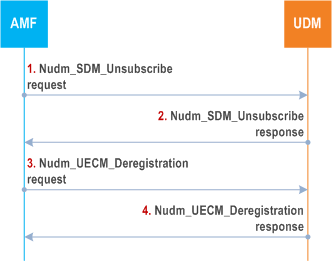
Step 1.
After purging the subscriber data and MM context of a deregistered UE, the AMF unsubscribes to changes to subscription data using Nudm_SDM_Unsubscribe request operation (see clause 5.2.3.3.4), for the data the AMF has previously subscribed (see clause 4.2.2.2.2, step 14b). The UDM unsubscribes the AMF from the data indicated.
The UDM may unsubscribe to changes to subscription data from UDR by using Nudr_DM_Unsubscribe for the data the UDM has previously subscribed (see clause 4.2.2.2.2, step 14b).
Step 2.
The UDM sends a response back using Nudm_SDM_Unsubscribe response operation.
Step 3.
The AMF deregisters from UDM using Nudm_UECM_Deregistration request (SUPI, NF ID, Access Type) operation (see clause 5.2.3.2.3). The UDM may update UE context in UDR by Nudr_DM_Update (SUPI, Subscription Data).
Step 4.
The UDM sets the UE Purged flag associated with the Access Type and acknowledges with a Nudm_UECM_Deregistration response operation.
4.6 Security procedures p. 223
Security procedures for the 5GS are specified in TS 33.501.
4.7 ME Identity check procedure p. 223
The AMF initiates Mobile Equipment Identity Check procedure by invoking the N5g-eir_MEIdentityCheck_Get service operation as defined in clause 5.2.4.2.2.
4.8 RAN-CN interactions p. 223
4.8.1 Connection Inactive and Suspend procedure p. 223
4.8.1.1 Connection Inactive procedure |R16| p. 223
This procedure may be initiated by the serving NG-RAN node when the UE is in CM-CONNECTED with RRC_CONNECTED state and has received the "RRC Inactive Assistance Information" from the AMF as defined in clause 5.3.3.2.5 of TS 23.501. NG-RAN initiates the transition to RRC_INACTIVE state as defined in TS 38.300.
4.8.1.1a Connection Inactive procedure with CN based MT communication handling |R18| p. 223
This procedure may be initiated by the serving NG-RAN node when CN based mobile terminating (MT) communication handling is requested for a UE that is configured with eDRX cycle value longer than 10.24 seconds for RRC_INACTIVE state and has at least one PDU session with active user plane as defined in clause 5.31.7 of TS 23.501.
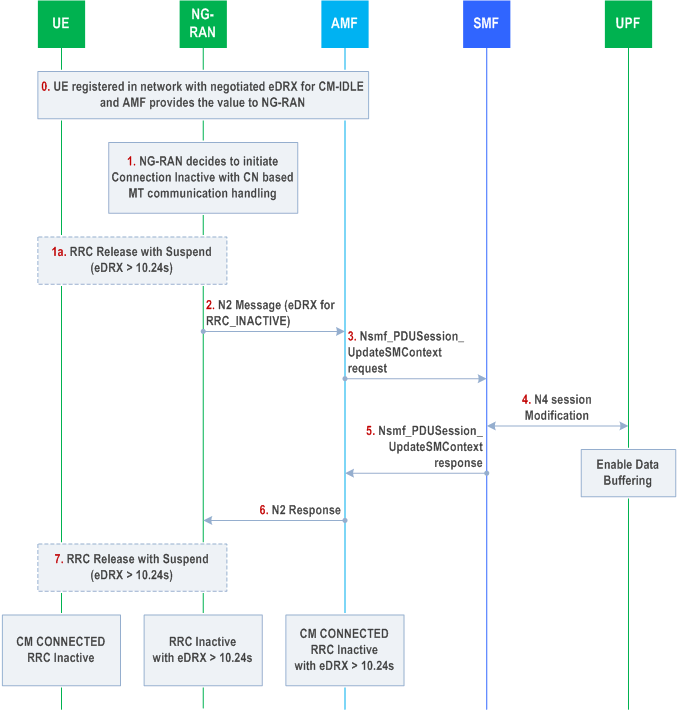
Step 0.
The UE is registered in the network with negotiated eDRX parameters for CM-IDLE state and is in CM-CONNECTED with RRC_CONNECTED state. The AMF provides the eDRX values for CM-IDLE state to NG-RAN as part of the RRC Inactive Assistance Information as defined in clause 5.3.3.2.5 of TS 23.501.
Step 1.
NG-RAN determines eDRX values for UE in RRC_INACTIVE state and decides to initiate Connection Inactive with CN based MT communication handling as specified in clause 5.31.7.2.4 of TS 23.501.
Step 1a.
Optionally the NG-RAN may initiate state transition from RRC_CONNECTED to RRC_INACTIVE with RRC configuring eDRX value as specified in TS 38.300. The NG-RAN may send the request in step 2 towards CN immediately following step 1a or the NG-RAN may delay this request towards CN as specified in clause 5.31.7.2.1 of TS 23.501.
Step 2.
Either immediately following step 1a or after having delayed the request for NG-RAN based on implementation, the NG-RAN sends N2 MT Communication Handling request message to AMF indicating the UE is transitioning to RRC_INACTIVE state. The CN takes the NG-RAN request into consideration and handles MT communication. The NG-RAN also provides the determined eDRX values for RRC_INACTIVE to AMF. The NG-RAN also provides the List of PDU sessions with active user plane resource.
If the NG-RAN receives DL NAS message and the UE is in RRC_INACTIVE with RRC configured eDRX and is considered not reachable, NG-RAN indicates to the AMF a NAS non-delivery and then initiates for the CN to handle mobile terminated (MT) communication.
Step 3.
For each of the PDU sessions with user plane resources as indicated by NG-RAN in step 2, the AMF invokes Nsmf_PDUSession_UpdateSMContext Request (PDU Session ID, Cause, Operation type, User Location Information, Age of Location Information, N2 SM Information (Secondary RAT usage data), CN based MT handling indication) towards SMF. The Operation Type is set to a value that indicates to stop user plane DL data transmissions towards the UE and enable data buffering. The SMF starts data buffering for MT data if the data buffering is handled in SMF. Based on local policy and/or an indication from the AMF, e.g. the RAT type is REDCAP or the CN based MT handling indication, the SMF triggers data size reporting in the case of DL data arrival.
Step 4.
If data buffering is handled in the UPF, the SMF updates the UPF with proper rules for MT data handling and DL data size reporting in the case of DL data arrival.
Step 5.
The SMF sends the Nsmf_PDUSession_UpdateSMContext response.
Step 6.
The AMF sends N2 MT Communication Handling response message to NG-RAN acknowledging the NG-RAN request and indicating the AMF has taken the NG-RAN request into account. The AMF considers the UE is in CM-CONNECTED with RRC_INACTIVE state.
Step 7.
If the UE connection is not released as specified in step 1a, the NG-RAN initiates state transition from RRC_CONNECTED to RRC_INACTIVE with RRC configuring the eDRX values as specified in TS 38.300.
4.8.1.2 Connection Suspend procedure |R16| p. 225
This procedure may be initiated by the serving NG-RAN node when the UE is in CM-CONNECTED and has at least one PDU session with active user plane connection and NG-eNB has received indication from the AMF that User Plane CIoT 5GS Optimisation, as defined in clause 5.31.18 of TS 23.501, is supported for the UE.
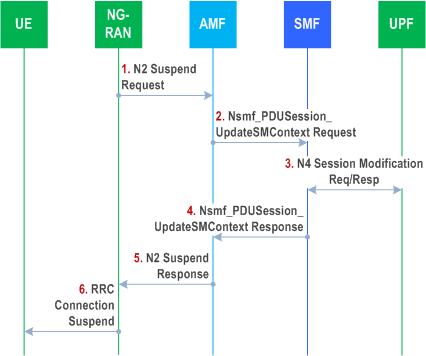
Step 1.
NG-RAN to AMF: The NG-RAN sends the N2 Suspend Request message to the AMF, see TS 38.413. The AMF enters CM-IDLE with Suspend indicator. Context information related to the NGAP UE association, UE Context and PDU session context, necessary to resume the connection is stored in the UE, NG-RAN node and in the AMF. The NG-RAN may include the Suspend cause and the N2 SM information.
If the UE is served by an NG-eNB that supports WUS, then the NG-eNB should include the Information On Recommended Cells And RAN nodes For Paging in the N2 Suspend Request message; otherwise NG-RAN may include the Information On Recommended Cells And NG-RAN For Paging in the N2 Suspend Request message. If available, the AMF shall store this information to be used when paging the UE.
The NG-RAN includes Information for Enhanced Coverage, if available, in the N2 Suspend Request message.
If Service Gap Control is being applied to the UE (see clause 4.3.17.9) and the Service Gap timer is not already running, the Service Gap timer shall be started in the AMF when entering CM-IDLE, unless the connection was initiated after a paging of an MT event, or after a mobility registration procedure without Follow-on Request indication or after a mobility registration procedure for regulatory prioritized services like Emergency services or exception reporting.
Step 2.
AMF to SMF: For each of the PDU Sessions in the N2 Suspend Request, the AMF invokes Nsmf_PDUSession_UpdateSMContext Request (PDU Session ID, Cause, Operation type, User Location Information, Age of Location Information, N2 SM Information (Secondary RAT usage data)). The Operation Type is set to "UP Suspend" to indicate suspend of user plane resources for the PDU Session.
Step 3.
SMF to UPF: N4 Session Modification Request (AN Tunnel Info to be suspended, Buffering on/off).
The SMF initiates an N4 Session Modification procedure indicating the need to release the tunnel info of AN terminating N3 between AN and UPF. Buffering on/off indicates whether the UPF shall buffer incoming DL PDU or not.
The UPF sends N4 Session Modification Response to acknowledge the SMF request.
The SMF shall maintain the N3 tunnel info (including both AN Tunnel Info and the CN Tunnel Info).
Step 4.
SMF to AMF: The SMF sends Nsmf_PDUSession_UpdateSMContext response to the AMF.
Step 5.
AMF to NG-RAN: After response for each PDU session in step 4, the AMF sends N2 Suspend Response to NG-RAN to successfully terminate the Connection Suspend procedure initiated by the NG-RAN, see TS 38.413.
Step 6.
The NG-RAN sends RRC message to suspend the RRC Connection towards the UE including UE Resume ID, see TS 36.300).
If Service Gap Control is applied for the UE (see clause 5.31.16 of TS 23.501) and the Service Gap timer is not already running, the Service Gap timer shall be started in the UE when entering CM-IDLE, unless the connection was initiated as a response to paging of an MT event, or after a mobility registration procedure without Follow-on Request Indication set or after a mobility registration procedure for regulatory prioritized services like Emergency services or exception reporting.
4.8.2 Connection Resume procedure p. 226
4.8.2.1 General |R16| p. 226
The Connection Resume procedure is used by a UE to request the establishment of a secure connection between a UE and the network when the UE is in CM-CONNECTED with RRC_INACTIVE state, or in CM-IDLE with Suspend indicator for the UE supporting User Plane CIoT 5GS Optimisation. The UE initiates the procedure when upper layers or the AS (when responding to RAN paging or upon triggering RNA updates) requests the resumption of a suspended RRC connection. NG-RAN details are specified in TS 38.300 and TS 38.331 for NR and in TS 36.300 and TS 36.331 for E-UTRA.
4.8.2.2 UE Triggered Connection Resume in RRC_INACTIVE procedure |R16| p. 226
The Connection Resume procedure is used by the UE in RRC_INACTIVE state, e.g. to transition to RRC_CONNECTED state or for Small Data Transmission while in RRC_INACTIVE as specified in TS 38.300. Triggers for the UE to initiate this procedure are defined in clause 5.3.3.2.5 of TS 23.501.
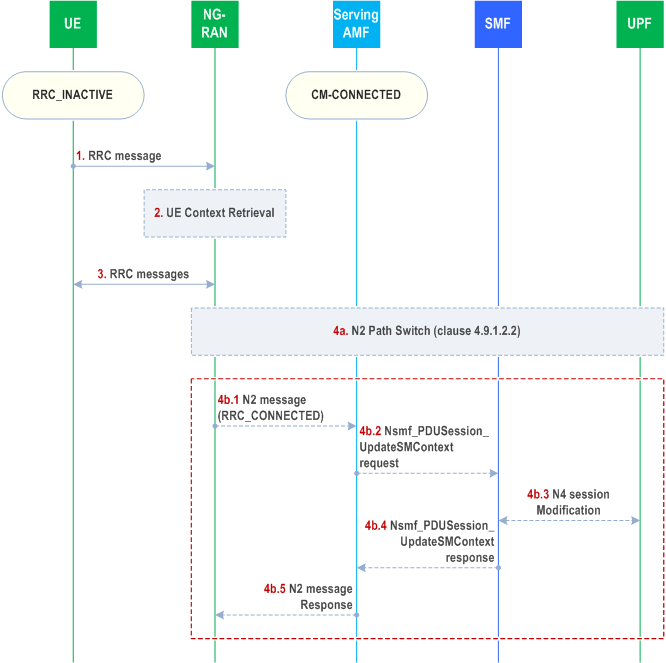
Step 1.
If NG-RAN determines that the connection resume is for Small Data Transmission as defined in TS 38.300 and step 4a or steps 4b.1 to 4b.5 have been performed, then NG-RAN keeps the UE in RRC_INACTIVE state and the UL/DL Small Data are transferred via the NG-RAN. Based on the procedures defined in TS 38.300, if the UE is re-configured with RRC Inactive with eDRX>10.24s, the NG-RAN may send an N2 message to 5GC as described in step 2 in clause 4.8.1.1a so the CN can then handle mobile terminated (MT) communication.
UE to NG-RAN: RRC message (Resume ID).
The UE initiates connection resume from RRC_INACTIVE state, see TS 38.300. The UE provides its Resume ID needed by the NG-RAN to access the UE's stored Context.
Step 2.
[Conditional] NG-RAN performs UE Context Retrieval.
UE Context Retrieval is performed when the UE Context associated with the UE attempting to resume its connection is not locally available at the accessed NG-RAN. The UE Context Retrieval procedure via NG-RAN is specified in TS 38.300.
Step 3.
NG-RAN to UE: RRC messages.
NG-RAN determines whether the UE shall be transitioned to RRC_CONNECTED state or kept in RRC_INACTIVE (e.g. the latter in the case of Small Data Transmission as defined in TS 38.300).
Step 4a.
[Conditional] N2 Path switch procedure.
If the accessed NG-RAN is different from the last serving NG-RAN and is able to retrieve the UE Context, the accessed NG-RAN node initiates N2 Path Switch procedure, i.e. steps 1 to 8 of clause 4.9.1.2.2 and including Xn data forwarding.
If the Connection Resume procedure is a response to RAN paging which is triggered by 5GC due to an N2 interface procedure, NG-RAN and 5GC handle the N2 interface procedure as a collision described in clause 4.9.1.2.
If Connection Inactive procedure with CN based MT communication handling (see clause 4.8.1.1a) has been performed previously then when the path switch procedure is performed downlink data or signalling delivery is triggered, if there is any.
If NG-RAN supports PDU Set based handling, then NG-RAN includes PDU Set Based Handling Support Indication in N2 Path Switch request message as described in clause 5.37.5.3 of TS 23.501. With the indication, the SMF may determine to activate PDU Set based Handling as described in clause 5.37.5.3 of TS 23.501.
Step 4b.
[Conditional] N2 Notification:
Step 4b.1.
If the accessed NG-RAN is the same as the NG-RAN that configured RRC_INACTIVE and still has the UE context, NG-RAN sends:
Step 4b.2.
- an N2 Notification to the AMF indicating the UE is in RRC_CONNECTED, if an AMF requested N2 Notification (see clause 4.8.3); or
- an MT Communication Handling request to the AMF indicating the UE is now reachable for downlink data and/or signalling if Connection Inactive procedure with CN based MT communication handling (see clause 4.8.1.1a) has been performed previously. The NG-RAN also provides the List of PDU sessions with active user plane resource.
The AMF invokes Nsmf_PDUSession_UpdateSMContext Request towards SMF indicating the Downlink data delivery for each PDU session with active user plane as indicated by NG-RAN in step 4b.1, if the AMF has requested data buffering as described in clause 4.8.1.1a.
Step 4b.3.
N4 session modification procedure is triggered by the SMF. If data buffering is handled in the UPF, the SMF updates the UPF with appropriate rules to trigger data delivery.
Step 4b.4.
The SMF sends the Nsmf_PDUSession_UpdateSMContext response.
Step 4b.5.
The AMF sends the N2 MT Communication Handling response message to NG-RAN.
4.8.2.2a Network Triggered Connection Resume in RRC_INACTIVE procedure |R17| p. 228
The Network Triggered Connection Resume in RRC_INACTIVE procedure is used when the NG-RAN needs to send data (e.g. the N1 NAS PDU and/or downlink user plane PDU) to a UE in the RRC_INACTIVE state. During the procedure, the NG-RAN sends a RAN Paging to the UE in order to trigger the Connection Resume in RRC_INACTIVE procedure in clause 4.8.2.2.
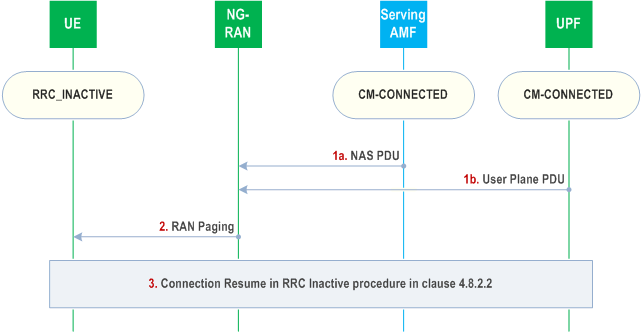
Step 1.
The NG-RAN receives downlink data (e.g. the N1 NAS PDU and/or the user plane PDU) for a UE in RRC_INACTIVE State, the NG-RAN buffers the downlink data and triggers RAN Paging message.
If the NG RAN supports the Paging Cause Indication for Voice Service feature and if the UE context in NG-RAN indicates that the UE supports the Paging Cause Indication for Voice Service feature, the NG RAN shall provide the Voice Service Indication in the RAN Paging message for the UE when it detects that the downlink data which triggers the RAN Paging message is related to voice service, as specified in clause 5.38.3 of TS 23.501.
Step 2.
The NG-RAN sends the RAN Paging message to the UE.
Step 3.
If the UE is in RRC_INACTIVE State, based on the RAN paging and the UE decides to accept the paging, the UE initiates the UE Triggered Connection Resume in RRC_INACTIVE procedure (see clause 4.8.2.2).
4.8.2.2b Network Triggered Connection Resume in RRC_INACTIVE with CN based MT communication handling |R18| p. 229
When the UE is in CM-CONNECTED with RRC_INACTIVE state with CN based mobile terminating (MT) communication handling, high latency communication as described in clause 5.31.8 of TS 23.501 is applied.
This procedure may be triggered by MT data, or a N1 procedure from SMF and UPF as shown in Figure 4.8.2.2b-1. When the procedure is triggered by other NFs (e.g. SMSF, LMF, GMLC), the UPF (or SMF) in the following figure should be replaced by the respective NF (the corresponding service operations used by other NFs when they communicate with AMF may also be different from the service operations used by SMF/UPF). For MT-SMS delivery request from SMSF, see also procedures defined in clause 4.13.3.6, clause 4.13.3.7 and clause 4.13.3.8.
During the procedure, the NG-RAN (i.e. gNB) performs RAN paging towards the UE based on the N2 message from the AMF in order to trigger the UE triggered Connection Resume procedure in clause 4.8.2.2.
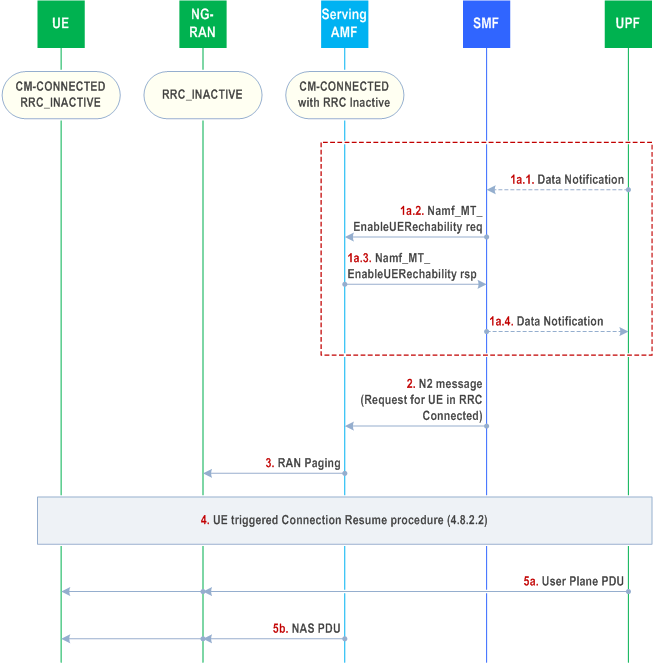
Step 1a.
When downlink data is received and the SMF/UPF is requested to perform buffering as specified in clause 4.8.1.1a, the UPF/SMF checks with AMF for the possibility of data delivery, similar to step 2 of clause 4.24.2 with the following differences:
MT_EnableUEReachability , or the SMF derive a different Paging Policy Indicator according to the additional Data Notification, the SMF invokes a new Namf_MT_EnableUEReachability indicating the higher priority or different Paging Policy Indicator to the AMF. The information contained in the new Namf_MT_EnableUEReachability request may override the information from the previous Namf_MT_EnableUEReachability request that is stored in the AMF based on local configuration. If the SMF receives any additional Data Notification messages due to additional data packets for another QoS Flow associated with same or lower priority than the priority indicated to the AMF in the previous Namf_MT_EnableUEReachability or if the SMF has sent the second Namf_MT_EnableUEReachability message indicating the higher priority, based on local configuration, the SMF either buffers these Data Notification messages and does not send a new Namf_MT_EnableUEReachability message, or the SMF sends a new Namf_MT_EnableUEReachability message to AMF. If AMF receives DL data sizes for different QoS Flows from SMF, based on local configuration, the AMF may store the DL data size information for each QoS Flows and provides the information per QoS Flow to NG-RAN as in step 2 below.
Step 2.
- The UPF provides the DL data size information of the QoS Flow when sending Data Notification to SMF if the UPF has received instruction from SMF.
-
In the Namf_
MT_ the SMF may also send the following parameters the PPI, the ARP and the 5QI, DL data size and/or QFI for the QoS Flow of the PDU Session which triggered the request for paging policy differentiation as defined in clause 5.4.3.2 of TS 23.501.EnableUEReachability -
The AMF determines if the UE is reachable based on the stored eDRX values for RRC_INACTIVE state provided by NG-RAN in clause 4.8.1.1a. If the UE is unreachable, the AMF stores the information received in the Namf_
MT_ request and provides the Estimated Maximum Wait time in the reject response message based on the eDRX values for RRC_INACTIVE in AMF (steps 2-5 are postponed until the UE becomes reachable). If the UE is considered reachable, step 2 is executed immediately.EnableUEReachability
When the AMF determines that the UE is reachable, the AMF sends a RAN Paging Request message to NG-RAN with the request for the UE's RRC connection to be resumed. The AMF may include the following parameters in the RAN Paging Request message to trigger and enable RAN paging:
Step 3.
- On per QoS Flow basis the PPI, the ARP, DL data size, the 5QI and/or QFI for the QoS Flow(s) of the PDU Session; and/or
-
A DL Signalling indication if the AMF receives MT signalling (i.e. via Namf_
Communication_ ) in step 1a.N1N2MessageTransfer
NG-RAN performs RAN paging towards the UE considering the parameters provided by the AMF. Based on the QFI and/or the DL data size for QoS Flow(s), if provided, the NG-RAN determines whether to set the MT-SDT indication as defined in TS 38.300).
Step 4.
When the UE receives RAN paging, it initiates the UE triggered Connection Resume procedure and NG-RAN notifies CN as specified in clause 4.8.2.2 including the N2 Notification in step 3b. If the Namf_MT_EnableUEReachability response was not sent in step 1.a.3 (i.e. the AMF has considered the UE is reachable in step 1), then the AMF sends the Namf_MT_EnableUEReachability response to the SMF along with step 4 of the UE triggered Connection Resume in RRC_INACTIVE procedure (see clause 4.8.2.2).
Step 5.
The UPF triggers downlink data delivery if there is any. The AMF sends downlink NAS messages if there is any.
4.8.2.3 Connection Resume in CM-IDLE with Suspend procedure |R16| p. 231
For the UE supporting User Plane CIoT 5GS Optimisation, the Connection Resume procedure is used by the UE to perform RRC_IDLE with Suspend to RRC_CONNECTED state transition. Triggers for the UE to initiate this procedure are defined in clause 5.31.18 of TS 23.501.
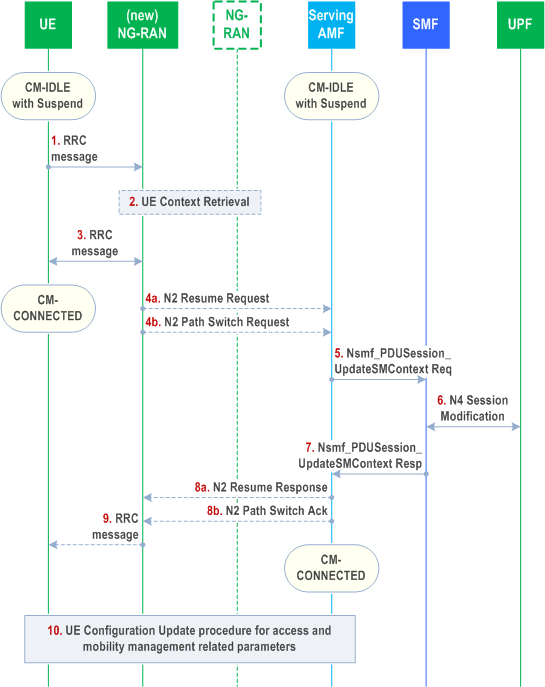
Step 1.
UE to NG-RAN: RRC message (Resume ID).
The UE initiates the transition from CM-IDLE and RRC_IDLE state with Suspend to CM-CONNECTED and RRC_CONNECTED state, see TS 36.300. The UE provides its Resume ID needed by the NG-RAN to access the UE's stored Context.
Step 2.
[Conditional] NG-RAN performs UE Context Retrieval.
UE Context Retrieval may be performed when the UE Context associated with the UE attempting to resume its connection is not locally available at the accessed NG-RAN. The UE Context Retrieval procedure via NG-RAN is specified in TS 38.300.
Step 3.
NG-RAN and UE continues the resume procedure and access stratum configuration synchronization is performed between the UE and the network. UE enters CM-CONNECTED and RRC_CONNECTED.
Step 4.
NG-RAN to AMF:
Step 5.
- If the NG-RAN is the same as the NG-RAN when UE is suspended, the NG-RAN sends N2 Resume Request to AMF including Resume cause and N2 SM information which indicates the PDU sessions successfully resumed and PDU sessions failed or partially failed to resume the user plane resource.
- If the NG-RAN is different from the NG-RAN when UE is suspended and the new NG-RAN is able to retrieve the UE Context from the old NG-RAN, the new NG-RAN node initiates N2 Path Switch Request towards AMF, i.e. Steps 1b of clause 4.9.1.2.2.
AMF to SMF: For each of the PDU Sessions indicated in step 4, the AMF invokes Nsmf_PDUSession_UpdateSMContext Request (PDU Session ID, Cause, Operation type, User Location Information, Age of Location Information, N2 SM Information). The Operation Type is set to "UP Resume" to indicate resume of user plane resources for the PDU Session.
For PDU Session(s) to be switched to the new NG-RAN, upon receipt of the Nsmf_PDUSession_UpdateSMContext request, the SMF determines whether the existing UPF can continue to serve the UE. If the existing UPF cannot continue to serve the UE, steps 3 to 7 of clause 4.9.1.2.3 or clause 4.9.1.2.4 are performed depending on whether the existing UPF is a PDU Session Anchor and flow continues in step 7. Otherwise, step 6 is performed if the existing UPF can continue to serve the PDU Session.
If the RRC connection is resumed and the UE is accessing via the NB-IoT RAT with the RRC resume cause set to "MO exception data" the AMF updates all (H-)SMFs. If AMF indicates "MO exception data" then it includes the MO Exception Data Counter. The AMF maintains the MO Exception Data Counter for Small Data Rate Control purposes as described in clause 5.31.14.3 of TS 23.501. Each (H-)SMF should be updated for every RRC Connection which is triggered for "MO exception data".
In the home-routed roaming case, if Small Data Rate Control applies, the V-SMF waits for H-SMF response before proceeding with the N3 establishment.
Step 6.
SMF to UPF: N4 Session Modification Request (AN Tunnel Info to be resumed, Buffering on/off).
The SMF initiates an N4 Session Modification procedure indicating the resume of AN tunnel. Buffering on/off indicates whether the UPF shall buffer incoming DL PDU or not.
If step 4a) is performed, the AN tunnel info is the one maintained by the SMF during Connection Suspend procedure, step 3 of clause 4.8.1.2. If step 4b) is performed, the AN tunnel info is part of the N2 SM information received by SMF in step 5.
The UPF sends N4 Session Modification Response to acknowledge the SMF request.
Step 7.
SMF to AMF: The SMF sends Nsmf_PDUSession_UpdateSMContext response to the AMF.
If new CN tunnel information is allocated for the PDU session, i.e. in the case of new AN tunnel is received in step 6, the SMF includes the new CN tunnel information as part of the N2 SM information.
If the resume for PDU session is unsuccessful, the SMF shall include the resume failure as part of the N2 SM information.
Step 8.
AMF to NG-RAN: After response for each PDU session in step 7, the AMF sends N2 Resume Response to NG-RAN and indicates success, including N2 SM information for PDU session received in step 7, if at least one PDU session is resumed successfully. If none of the PDU sessions is resumed successfully, AMF indicates failure to NG-RAN.
The AMF sends N2 Path Switch Acknowledge with PDU session resume information, if Path Switch Request is received in step 4.
The AMF may provide Extended Connected Time value to the NG-RAN. If the NG-RAN receives the Extended Connected Time value, the NG-RAN may take this information into account when determining user inactivity.
Step 9.
[Conditional] NG-RAN to UE: RRC message.
The NG-RAN may reconfigure the RRC connection based on resume result received from AMF.
Step 10.
If the AMF has paged the UE to trigger the Connection Resume procedure, the AMF shall initiate the UE configuration update procedure as defined in clause 4.2.4.2 to assign a new 5G-GUTI.
4.8.2.4 Connection Resume in CM-IDLE with Suspend and MO EDT procedure |R16| p. 232
The Connection Resume with Early Data Transmission procedure is used by the UE to optimise sending user data in a single uplink packet and single uplink followed by single downlink packet cases for a UE in CM-IDLE with Suspend.
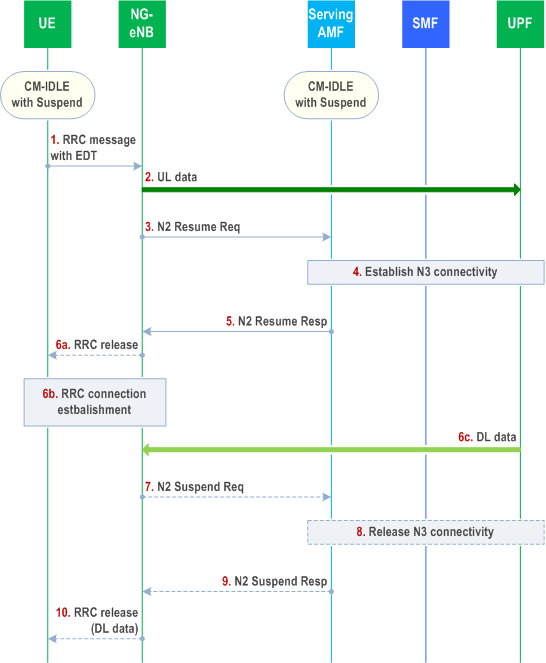
Step 1.
UE to NG-eNB: RRC message (Resume ID, AS RAI) with UL EDT.
The UE initiates the transition from RRC_IDLE with Suspend state to RRC_CONNECTED state, see TS 36.300.
The UE may include AS Release Assistance information indicating:
Step 2.
- No further Uplink and Downlink Data transmission, or
- Only a single Downlink Data transmission subsequent to the Uplink transmission.
The NG-eNB deciphers the EDT UL data received from the UE and forwards it to the UPF using the N3 UL TEID in the AS context.
Step 3.
The NG-eNB sends N2 Resume Request to AMF including Resume cause and N2 SM.
If the UE included AS Release Assistance information indicating No further Uplink and Downlink Data transmission in step 1, NG-eNB may request for immediate transition to RRC_IDLE with Suspend.
If the NG-eNB requests for immediate transition to RRC_IDLE with Suspend, the NG-eNB should include Paging Assistance Data for CE capable UE in the N2 Resume Request message. If the NG-eNB supports WUS and requests for immediate transition to RRC_IDLE with Suspend, the NG-eNB should include Information on Recommended Cells and RAN Nodes for Paging in the N2 Resume Request message. The AMF stores this information in the UE context for subsequent Paging procedure.
Step 4.
[Conditional] The AMF interacts with SMF to establish the N3 tunnel, except for the case:
Step 5.
- The AMF receives a request for immediate transition to RRC_IDLE with Suspend in step 3; and
- the AMF is not aware of any downlink data or signalling pending.
The AMF sends an N2 Resume Response to NG-eNB.
If the AMF received a request for immediate transition to RRC_IDLE with Suspend in step 3 and there is no downlink data or signalling pending, the AMF includes a Suspend indication, keeps the UE in CM-IDLE with Suspend and restarts the Periodic Registration Timer unless the Strictly Periodic Registration Timer Indication has been provided to the UE during the previous registration procedure.
Otherwise the AMF sends an N2 Resume Response to NG-eNB after the N3 Connectivity has been established and moves the UE to CM-CONNECTED. If the AMF knows of mobile terminating data or signalling pending, the AMF may include the Extended Connected Time value to the RAN
Step 6.
[Conditional] RRC procedure:
Step 6a.
Step 7-9.
If the AMF included the Suspend indication, the NG-eNB releases the RRC Connection with Suspend. The procedure is complete and following steps are skipped.
Step 6b.
If the AMF did not include the Suspend indication and:
Step 6c.
- The UE did not include AS Release Assistance Indication; or
- The AMF included the Extended Connected Time value.
Otherwise, if the AMF did not include Extended Connected Time value and the UE included AS Release Assistance information with only a single Downlink Data transmission subsequent to the Uplink transmission, the NG-eNB waits for the DL data to arrive and proceeds to steps 7-10.
The NG-eNB releases the N3 connectivity by sending an N2 Suspend Request to AMF including Suspend cause and N2 SM. Steps 2-4 of Connection Suspend procedure in clause 4.8.1.2 is executed.
Step 10.
[Conditional] NG-eNB to UE: RRC message (with DL data).
The NG-eNB ciphers received DL data.
The NG-eNB releases the RRC Connection with Suspend including the DL EDT data.
4.8.3 N2 Notification procedure p. 234
This procedure is used by an AMF to request the NG-RAN to report RRC state information, when the target UE is in CM-CONNECTED state. When AMF has requested reporting of subsequent state changes, the need for the NG-RAN to continue reporting ceases when the UE transitions to CM-IDLE or the AMF sends a cancel indication. This procedure may be used for services that require RRC state information (e.g. 5GC MT control and paging assistance, O&M and collection of statistics), or for subscription to the service by other NFs. See TS 38.413 for details of the procedure.
Reporting of RRC state transitions can be requested per UE by AMF. Continuous reporting of all RRC state transitions can be enabled by operator local configuration.
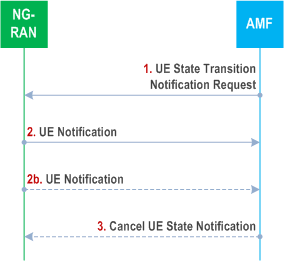
Step 1.
The AMF sends a UE State Transition Notification Request to the NG-RAN as described in TS 38.413. The UE State Transition Notification Request message shall identify the UE for which notification(s) are requested and may contain a reporting type. The reporting type either indicates subsequent state transitions shall be notified at every RRC state transition (i.e. from RRC_CONNECTED state to RRC_INACTIVE state, or from RRC_INACTIVE to RRC_CONNECTED state), or it indicates Single RRC_CONNECTED state notification.
Step 2.
The NG-RAN sends the UE Notification message to report the current RRC state for the UE (i.e. RRC_INACTIVE state or RRC_CONNECTED state). The current UE location information (i.e. TAI + Cell Identity) is always included when RRC state information is reported.
Step 2b.
When the AMF has requested reporting about subsequent state transitions, the NG-RAN sends subsequent UE Notification messages to the AMF at every RRC state transition until the UE transitions to CM-IDLE or NG-RAN receives a Cancel UE State Notification message from the AMF.
When the AMF has requested reporting for Single RRC_CONNECTED state notification and UE is in RRC_CONNECTED state, the NG-RAN sends one UE Notification message but no subsequent messages. If UE is in RRC_INACTIVE state, the NG-RAN sends one UE Notification message plus one subsequent UE Notification message when RRC state transits to RRC_CONNECTED.
Step 3.
The AMF can send a Cancel UE State Notification message to inform the NG-RAN that it should terminate notifications for a given UE. This message should only be used when notification(s) about subsequent state transitions was requested at every RRC state transition.